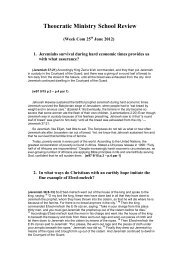1964 Awake! - Theocratic Collector.com
1964 Awake! - Theocratic Collector.com
1964 Awake! - Theocratic Collector.com
Create successful ePaper yourself
Turn your PDF publications into a flip-book with our unique Google optimized e-Paper software.
temperatures of high altitudes transform<br />
its .water vapor into billions of tiny water<br />
Qroplets. A cloud is formed that grows with<br />
great rapidity. A current of air rushes up<br />
into the newly formed thundercloud at a<br />
speed of about sixty miles per hour. This<br />
air turbulence is characteristic of a thun.<br />
dercloud. Because of such air action you<br />
may, at times, feel a strong breeze before<br />
the storm starts. Here in Morocco, as in<br />
many other countries, a breeze in the wintertime<br />
often indicates that rain is <strong>com</strong>ing,<br />
and soon. Sometimes the current of air<br />
flowing into the thundercloud is sufficiently<br />
strong to counteract the wind that is push.<br />
ing the clouds. This results in a calm before<br />
the storm.<br />
A well-developed thundercloud can push<br />
its massive head as high as 39,000 to 49,-<br />
000 feet. In such clouds almost all kinds<br />
of weather are manifested-rain, snow,<br />
hail, wind and lightning. As the storm begins,<br />
lightning flashes across the sky, fol·<br />
lowed by a clap of thunder. The clouds<br />
iight up intermittently like an old, defective<br />
neon sign, and then <strong>com</strong>es the rain.<br />
What a downpour that can be! It, can<br />
drench an area of a few miles with 100,000<br />
tons of water in a matter of minutes.<br />
It was during the years 1946 and 1947<br />
that scientists showed that the thunder·<br />
, cloud is mort:,'than just a mass of water<br />
droplets. Instead, it 'has a <strong>com</strong>plex structure.<br />
Its interior might be <strong>com</strong>pared to an<br />
immense honey<strong>com</strong>b, for it is made up of<br />
many cells or .. units that are separated from<br />
one another by walls of <strong>com</strong>paratively<br />
calm cloud. A large thundercloud may<br />
spread out over a distance of 250 miles,<br />
but within are these many cells that may<br />
be only three miles wide. Actually, each of<br />
the cells makes its own storm, and each<br />
produces its own lightning, thunder and<br />
rain. Many of them may be raining at the<br />
same time. Some may be just beginning,<br />
while others are in the middle of their<br />
NOV/fJMBER se, <strong>1964</strong><br />
rain cycle, and still others are tlnishing the<br />
cycle.<br />
The last stage of a thunderstorm is<br />
marked by a gentle drizzle that lets you<br />
know that the rain is about over. At this<br />
point the thundercloud develops its familiar<br />
anvil-shaped top. With this understand.<br />
ing of how a thundercloud is constructed,<br />
a person should feel free of any superstitious<br />
fear of It. A thundercloud is not an<br />
evil spirit or a god. Instead, it is a very<br />
natural thing that automatically' takes<br />
place in the atmosphere when conditions<br />
are right.<br />
Droplet8 of Water<br />
Clouds are great collections of water<br />
droplets. Since water is much denser than<br />
air, you may wonder how great cloud for·<br />
mations that weigh hundreds of thousands<br />
of tons because of the water in them can<br />
float on the air. It would seem that the<br />
water droplets that form the clouds would<br />
fall, and so they do, but because of their<br />
small size and the air resistance they encounter,<br />
they fall very slowly. Very little<br />
progress is made by them as they fall because<br />
of upward movements of air that<br />
push them up. When enough of them finally<br />
get together to form a large raindrop<br />
there is sufficient weight to over<strong>com</strong>e this<br />
upward action of air currents.<br />
What actually causes rain is still one<br />
of the most perplexing problems that confront<br />
the scientists who study clouds. It is<br />
not easy to explain how perhaps a hundred<br />
million droplets of water <strong>com</strong>e together<br />
in a cloud to form a raindrop. Nei·<br />
ther is it clear why these droplets that<br />
form clouds do not form raindrops in all<br />
clouds.<br />
One of the theories that attempts to explain<br />
the formation of raindrops claims<br />
that many clouds fly high in the atmosphere,<br />
with the result that their tops have<br />
15




